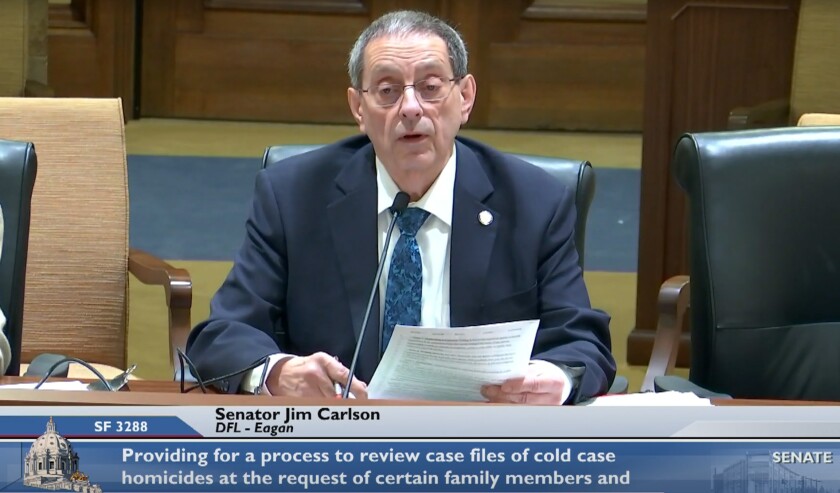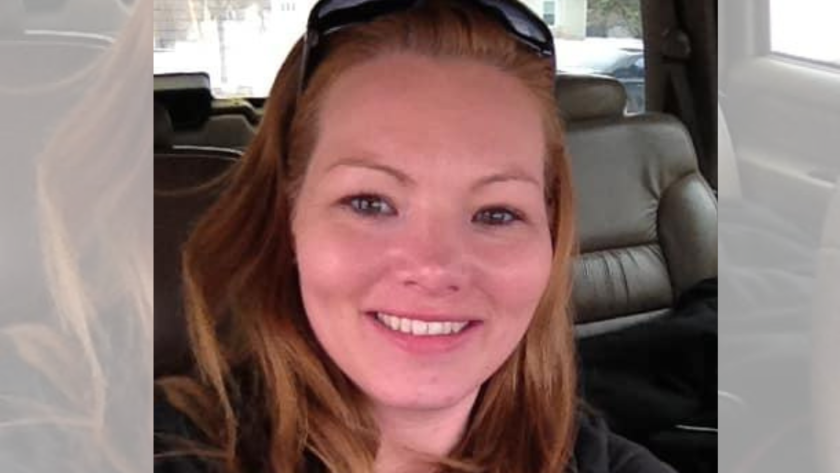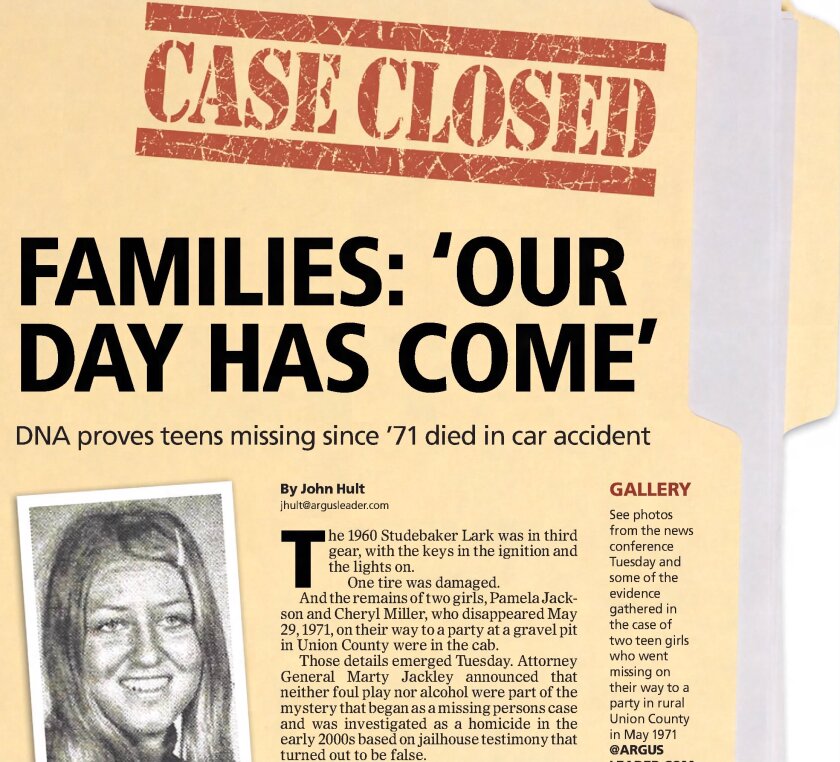ST. PAUL — Supporters of a new bill being hammered out by Minnesota legislators hope it will breathe new life into reinvestigating cold case murders on a consistent basis.
The bill, — Cold Case Homicide Review Process, and a bill, follow three other known states that have passed similar legislation by seeking to empower families of victims and survivors by forcing law enforcement agencies to reopen cases upon request.
ADVERTISEMENT
The bill, if passed, would benefit the more than 2,081 Minnesota families who have lost loved ones to violence and don’t know who the killer is.
Barry Jensen’s father, George, was killed on Nov. 19, 1979, in Bloomington, For five decades, Barry, his brother and other family members have lived in fear, anger, even shame.
“I speak from experience. When a murder happens, families are immediately thrust into a world they have no experience with. They are faced with the great unknown, along with sadness, fear, anger and frustration, and yes, somehow shame. That shame grows as the years pass by with no resolution and with no arrest,” Barry in February 2024.
“Obviously, this affected our family greatly, and in hindsight, I see I suffered some PTSD as I walked around my apartment with clenched fists. I was unable to work alone in my garage or outside at night,” Barry said.
His brother checks, double-checks, then triple-checks the locks on his doors every time he leaves his house.
“Fear has become part of our lives,” Barry said.
“Somehow it was shameful to have our father’s murder go unsolved. Did it mean we didn’t care? What did our friends in the world think of this?” Barry said.
ADVERTISEMENT
Throughout the decades, the Jensen family received few updates about the case, and people working the case retired or moved on, leaving Barry confused, he said.
“The world you knew changes, and you find yourself in a new one, one you don’t understand. One you cannot help but become lost in. A world that is full of pain, anger and confusion. It is easy to get lost, and the way out is an unclear path that you have never walked before,” he said.
Among other stipulations, the would require a different person to investigate a case that has gone cold; agencies to develop application processes to be used in requesting a reexamination of a cold case file, and for law enforcement agencies to submit annual reports and summaries of cold cases to state legislators and publish a report to the public on websites.

‘There is no definition of a cold case’
Sen. Jim Carlson, DFL-Eagan, wrote the bill with George Jensen’s unsolved murder in mind. Barry sat next to him when he introduced it to the Senate judiciary committee on Feb. 14.
Over the years, Carlson has received multiple requests from families of victims whose murder cases have gone cold, and he’s rarely been able to help. But if his bill passes, an avenue will open up for families needing help, he said.
“I find it funny that there is no definition of a cold case, no legal definition. It’s just a case that hasn’t been worked on for some time. These are cases that go on forever, and sometimes they have new information that should be looked at … where a fresh look can bring up something new,” Carlson said.
ADVERTISEMENT
Murder rates being solved — or using the word "cleared" — have been declining for decades, dropping to slightly below 50% in 2020, a new historic low.
“Unsolved murders have become a silent and unknown epidemic in America and in Minnesota, 33.4% of all murders in America from 1965 until 2022 were unsolved,” Barry said.
And because there is no central database of cold cases in Minnesota, Barry pointed to a privately managed database called that lists 2,081 cold cases.
“That’s 2,081 Minnesota families who are waiting on answers and would benefit from this bill,” Barry said.
Other states that have passed or are working to pass a similar bill like Minnesota include , and
A version of the bill also received bipartisan support in Congress and was signed into law by in 2022.
“This law being a federal law did not help my family, hence the need for a state version,” Barry said.
ADVERTISEMENT
Just cause?
a citizen lobbyist and noted as one of the state’s foremost authorities on public information, wanted elements of cold case reinvestigations, denied or accepted, to be made public.
“I applaud the bill before you that Sen. Carlson is doing. We’re talking about hundreds and hundreds of cases, and all these kinds of things sometimes come under a veil of secrecy,” Neumeister testified to the Senate judiciary committee.
Oftentimes, families are met with an uncaring attitude by law enforcement, Neumeister said.
“We do know that these active homicide investigations, you get nothing. The public has a right to know how agencies are responding to these kinds of requests,” Neumeister said.
Sen. Jeff Howe, R-Rockville, Minnesota, said just cause needs to be shown for a cold case to be reviewed.
“One concern that is out there, because these things take so long and the initial investigator may be the head of the agency by the time the request comes in, you inhibit the original investigator to review the case," he said.
The bill was laid over to be discussed later during the legislative session.
ADVERTISEMENT

North Dakota
When Casey Miller, chief agent with the North Dakota Bureau of Criminal Investigation, heard about the proposed bill in Minnesota, he hailed it as “good in theory.”
Miller said North Dakota does not have a similar law, and that there is also no Cold Case Unit within the BCI.
“If there is a law, I’ve never heard of it. I don’t recall anything like that,” Miller said of statutes in North Dakota that focus on reviving cold cases.
The advertises 13 cold cases on its website that are active investigations, meaning no information is available to be released.
The numbers reflected on the state's attorney general's office website are a “drop in the bucket,” Miller said, adding that typically when a case goes cold, NDBCI will try to assign cold cases out to agents who have the time.
“Right now, we don’t have a ‘Cold Case Unit,’ we just have what we refer to as agents, and we just give the case to an agent who has time to work on it,” Miller said.
ADVERTISEMENT
“Unfortunately, we can’t get to that all the time because we have active cases, too,” he said.
More often than not, new evidence is needed to resurrect a cold case, Miller said.
“It’s always a good thing to keep on everybody’s minds. But we have had homicides recently within the last couple years and still we have no suspects. Until some kind of piece of evidence happens … or what we see a lot is someone gets in trouble and goes to prison and they want to help themselves out, sometimes that happens, too,” he said.

The 2007 murder case of Anita Knutson in Minot but was reopened in 2022 after a former boyfriend of a suspect — Knutson’s former roommate, Nichole Erin Rice — told investigators that Rice admitted to killing Knutson in 2007 or 2008.
On March 16, 2022, Rice, who was a student at Minot State University known as Nichole Thomas at the time, was arrested. She later in Ward County District Court.
Erin Haustveit, a friend of the family and a former classmate of both Rice and Knutson, declined to speak to Forum News Service about the case or about cold cases in general, as Rice’s impending trial is in the near future, set for June this year in Ward County District Court.
If convicted, Rice faces life in prison without parole.
‘Robbing Peter to pay Paul’
In theory, the bill is “not a bad thing,” Miller said.
For a law enforcement agency to function properly, however, and retain investigators to work on active cases, the bill needs to address full-time employees.
“Let’s say it does pass, then you either have to give me some FTEs (full-time employees) so I can build a unit dedicated to this, or I assign my current agents to work it, which is pulling them off the caseload,” Miller said.
“It’s kind of robbing Peter to pay Paul because if I don’t get more people, then I take my current staff and have them work on cold cases, and my other staff have to pick up what is not getting done,” he said.
“In theory, it is a good idea. If it would come to North Dakota and was introduced in 2025 in session and there is a lot of support for it, then give us two FTEs who would work strictly on cold cases. These agents would be dedicated to just that and then that helps,” Miller said.
Alison Feigh, director of the Jacob Wetterling Resource Center, a program under the Zero Abuse Project in St. Paul, heard about the bill a couple weeks ago.
“I think any chance that allows families and law enforcement to be able to work together and pool resources is a good thing. We always want our families to have more choices. When people feel that things are frozen or especially having someone else take a look, having a fresh eye on the case can never be a bad thing,” she said.
Feigh is also concerned about the lack of an inclusive budget.
“Any time you are trying to change policy to have the financial backing makes those changes possible. I’m curious as to how this will be funded and if it’s something where they’re trying to pass policy first and then the funding,” she said.
There is an existing option for a law enforcement agency to get “fresh eyes on the case for free,” especially with children with a department at the National Center for Missing and Exploited Children called Team Adam, composed of retired law enforcement specialists, Feigh said.
“The heartening part of this legislation is that it’s not the old-school ownership of whose case it is, but who has resources that can be helpful,” she said.
Sen. Jim Carlson explained that the bill does not address budgets because cases can always be assigned to a different agency.
“Just by having it as a cold case doesn’t mean that a department doesn’t have resources on it. And cold cases can always be escalated,” he said, such as handed over to a sheriff’s department or the Minnesota Bureau of Criminal Apprehension.
South Dakota
Tony Mangan, spokesperson for the South Dakota Attorney General’s Office, said he couldn’t comment on pending legislation in other states, but that the state has an agent with the Division of Criminal Investigation who is “actively involved in dealing with cold case investigations.”
Out of the 146 cases the has listed on its website, Mangan the more than 10-year-old active cold case of Rachel Cyriacks, who on Nov. 13, 2013.
She was last seen traveling to Huron, and the last person to see her was her husband, Brad.
A month after Cyriacks disappeared, the family’s gray and black 1995 Silverado pickup truck was found on a bee farm near Huron. Additionally, Cyriack’s green, pink and white quilt, which vanished at the time of her disappearance, was found in her home.

“Throughout the years, we have received numerous tips, and we have checked all of them,” South Dakota Attorney General Marty Jackley said in 2023.
Another 1971 case that went cold was both students at Vermillion High ��������, who were on their way to a party in a gravel pit near Elk Point.
For years, nobody knew what happened to the two teenagers, and one suspect was indicted on murder charges related to the girls’ deaths. The charges were later dropped when investigators determined a jailhouse confession had been faked by another inmate.

It was only when river waters lowered in 2014 to reveal a rusted wreck that investigators found the girls, and families found some closure. Their car, a 1960 Studebaker Lark, had gone off the road and crashed while in third gear. It landed under a bridge of Brule Creek east of Union Grove State Park and less than a mile away from the gravel pit.
Their deaths, according to Jackley, indicated an accident occurred. Case solved.





















